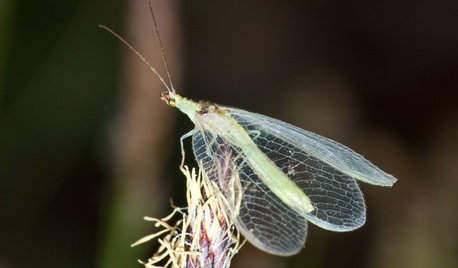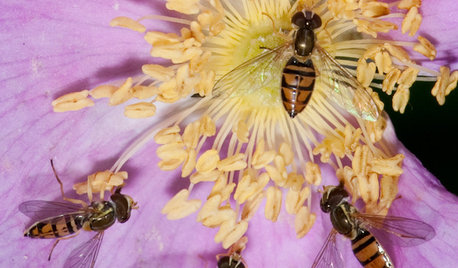Insect specialization, pests and predators/beneficials
Tiffany, purpleinopp Z8b Opp, AL
11 years ago
Related Stories

GARDENING GUIDESLook Out for Lacewings: Beneficial Insects Coming to a Garden Near You
Lacewings are delicate insects that produce alligator-like, hungry offspring that devour aphids and other garden pests
Full Story
GARDENING GUIDESThis Fly Is One of the Most Beneficial Insects Around
Meet the syrphid fly, a colorful pollinator that also beats chemicals for controlling aphids and other garden pests
Full Story
GARDENING GUIDESOrganic Matters: Thwart Insect Pests With Trap Crops
Add a few sacrificial plants to your garden to lure insects away from the harvest
Full Story
GARDENING FOR BUTTERFLIESGardening for the Bees, and Why It’s a Good Thing
When you discover how hard bees work for our food supply, you may never garden without them in mind again
Full Story
FALL GARDENING7 Reasons Not to Clean Up Your Fall Garden
Before you pluck and rake, consider wildlife, the health of your plants and your own right to relax
Full Story
GARDENING AND LANDSCAPINGBid Bad Garden Bugs Goodbye and Usher In the Good
Give ants their marching orders and send mosquitoes moseying, while creating a garden that draws pollinators and helpful eaters
Full Story
FARM YOUR YARDHello, Honey: Beekeeping Anywhere for Fun, Food and Good Deeds
We need pollinators, and they increasingly need us too. Here, why and how to be a bee friend
Full Story
GARDENING GUIDESInvite Mining Bees to Your Garden by Planting Their Favorite Plants
Look for mining bees (Andrena) pollinating woodland wildflowers in U.S. gardens this spring
Full Story
BENEFICIAL INSECTSAttract Pollinators for a Productive Edible Garden
You can lure bees, butterflies and birds into your yard with the right flowers and nesting spots
Full Story
EDIBLE GARDENSGarden BFFs? Why Your Vegetables Are Begging for Companion Plants
Foster friendships among plants for protection from pests, pollination support and color camaraderie
Full Story








jean001a
rhizo_1 (North AL) zone 7
Related Professionals
Goodyear Landscape Contractors · Edmond Landscape Contractors · Bainbridge Island Landscape Contractors · Belmont Landscape Contractors · Eagle Landscape Contractors · Flagstaff Landscape Contractors · Glendale Heights Landscape Contractors · Hoover Landscape Contractors · Laguna Hills Landscape Contractors · Long Beach Landscape Contractors · Point Pleasant Landscape Contractors · Shoreview Landscape Contractors · Suitland Landscape Contractors · Waterford Landscape Contractors · Bensenville Landscape ContractorsKimmsr
kimpa zone 9b N. Florida.
tsugajunkie z5 SE WI ♱